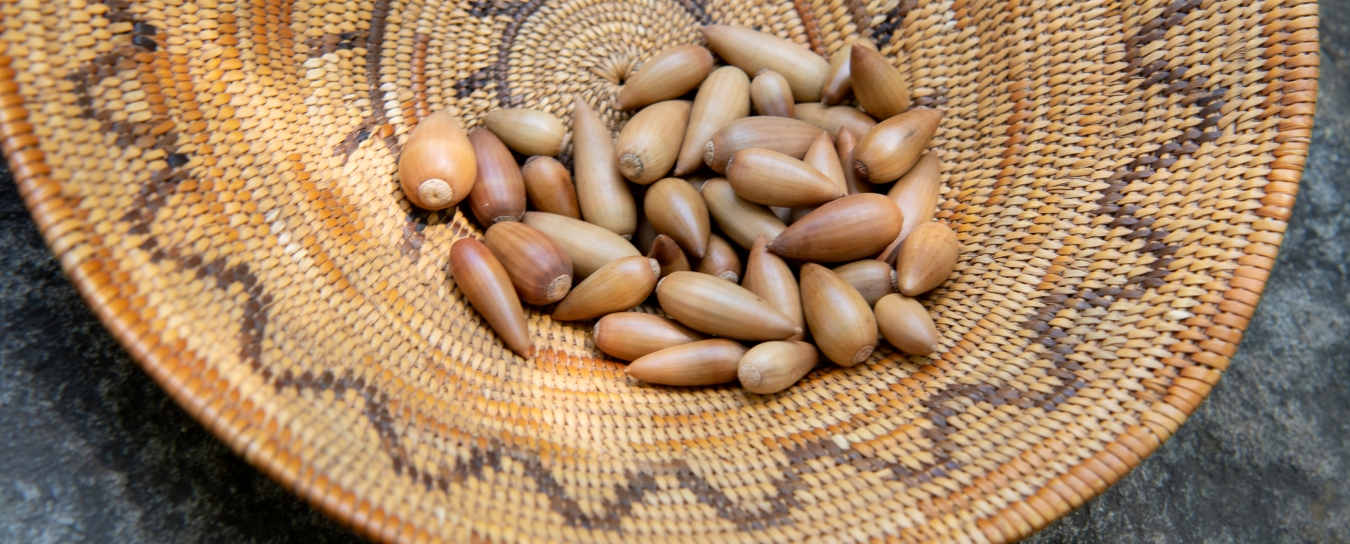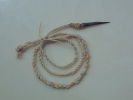
Anthropology
Check our anthropology FAQ for information about artifacts and more. Our Chumash Life pages for teachers and students provide a basic introduction to some aspects of traditional daily life.
- Anthropology
- Rocks & Fossils
- Invertebrates
- Vertebrates
- Botany
- Astronomy
- Fungi
- General
- Recently Asked
Chumash bows and arrows
Do you have any Chumash bows or arrows on display or in the backroom archives? Do you know what plants the Chumash used for their arrows? In SoCal, the Kumeyaay used reed (Phragmitis) or arrow-weed (Pluchea) most often. I am interested because I build Kumeyaay bows and arrows and would like to build a Chumash one. BTW, if you have any in need of repair, I can show you how to do this. Thanks for any help. Kevin
Curator Response
Hi Kevin,
Thank so much you for asking about Chumash bows and arrows, and kindly offering your skills and expertise! Associate Curator Brian Barbier, M.A., is a dedicated experimental archaeologist who loves to study and practice Native technology skills and work with others who are similarly inclined, so it’s good to meet you.
We are very proud to display a rare Chumash arrow-making kit—over 200 years old—right at the entrance of Chumash Life; we hope you can come have a look at it sometime. The entire kit was well-preserved in a dry cave in the backcountry, wrapped in a Tule mat. It includes California Condor and hawk feathers, snake skin, shafts, deer bone, paint applicator, flaked tools, plant bundles, a leather hand guard, hafted shark’s tooth, a tiny point, shell beads, and cordage of Dogbane, nettle, milkweed, yucca, and sinew. Elsewhere in Chumash Life, you can also see a bow, quiver, and several arrows of different styles and time periods.
You will find a wealth of information about the plants used in the manufacture of bow and arrow technology in Chumash Ethnobotany by Curator Emeritus of Ethnography Jan Timbrook, Ph.D. The main source of Chumash Ethnobotany is the wonderful trove of Chumash plant knowledge kept by Luisa Ygnacio, Lucrecia García, Mary Yee, Juan Justo, María Solares, Rosario Cooper, Fernando Librado, Simplicio Pico, and Candelaria Valenzuela, as recorded in the notes of linguist J. P. Harrington. Below is a very condensed list of bow-and-arrow-related plants listed in the book, which you may find helpful as a beginning.
One-leaf Piñyon (called posh in Barbareño, Ineseño, and Ventureño Chumash—see the book for Chumash names of all these plants) was considered the best wood for bows. Dogwood, Live Oak, and Blue Elderberry could also be used. California Juniper could be used in sinew-backed bows, but had noted flaws. Pines were also instrumental in providing pine pitch, which—mixed with tar—fixes points to arrow foreshafts.
Arrow foreshafts could be made of Scrub Oak, Chamise, and Coastal Sagebrush. Phragmites, which you mention, was used for arrow shafts, as were Giant Rye and Toyon. Nuttall’s Snowberry was used to make toy arrows.
Dogbane was used to make cordage, including bowstrings.
There’s so much more information about bow-and-arrow-making in the book, including the plants used to create tools for making different parts, and plants involved in other cultural practices related to bows and arrows. Chumash Ethnobotany can be found in the Museum Library (hopefully for as long as the Museum exists) as well as in our store (for the time being, as of 2022 we don’t have many copies left).
Extending beyond the plant knowledge, you can find more complete information about bows and arrows in The Material Culture of the Chumash Interaction Sphere, vol. I: Food Procurement and Transportation, also found in our store and library.
We hope you find this information interesting and helpful,
Associate Curator Brian Barbier, M.A., Curator Emeritus of Ethnography Jan Timbrook, Ph.D., and Curator of Anthropology John R. Johnson, Ph.D.
Kevin response:
Thank you so much, Brian. Great information. I'm pleased that we have some of the plants here in San Diego County. With difficulty, I have found some chamise that is relatively straight, but scrub oak? This would take loads of work to straighten. Perhaps in wetter climate it grew straighter. Your cache of materials found in the cave sounds fantastic. I can't wait to see it.
You mentioned tar, used with pine pitch. Is this asphaltum? If so, I'll have to pick some up in the parking lot of the Brea Tar Pits on my way up to your museum.
Thanks again, Kevin
Curator response:
Very glad to hear we have been helpful, Kevin.
Although Scrub Oak is often gnarled, it had compensating virtues. As I noted in Chumash Ethnobotany: “It is very flexible and strong, Simplicio Pico said, and a stick of it could be bent double without breaking.” Since it was used for foreshafts, only a short piece had to be straight.
The Chumash traditionally made two types of arrows:
Self arrows: one straight shaft of fairly hard wood, usually just sharpened to a point at the end or sometimes with a stone point attached. These are for smaller game like rabbits or birds to be shot at close range. They may or may not have been fletched. For this type you do want wood that naturally grows long and straight so Chamise or Toyon would be better than Scrub Oak. Some other tribes used arrowweed (Pluchea), but I don’t have definite record of that among the Chumash.
Compound arrows: the stone point was attached to a 6–~8 inch long hardwood foreshaft, which was inserted into a lightweight cane mainshaft. This type had fletching of one eagle and two Red-tailed Hawk feathers to help the arrow fly straight, and was used to hunt larger game like deer. We have some of these on exhibit. The Carrizo Cane mainshaft (Phragmites australis or Leymus condensatus) would usually require some straightening by manipulating it in the groove of a heated soapstone shaft straightener.
More information about straightening and preparing the parts of an arrow can be found in the sources recommended above, as well as Chumash Archery Equipment by our former curator, Travis Hudson, published by San Diego Museum of Man, 1974. This is also available for consultation in our Museum Library.
Yes, the tar would be asphaltum. If you visit Santa Barbara, you can pick up a lot of it without even trying, just by walking around barefoot on the beach. But the Chumash said that malak, the soft tar found on the beach, wasn’t good for anything. For caulking, waterproofing, and as an adhesive, what you want is woqo, the hard tar that’s oozed out on land and been exposed to the air. You pound it to powder and melt it together with pine pitch. That makes it somewhat malleable, neither too sticky nor too brittle.
Dr. Timbrook
Kevin response:
Dr Timbrook, thank you for your information and I love your book! It is wonderful that you include some information on surrounding tribes. I have made arrows of arrow weed and Phragmites mostly, but a few chamise and even a couple of desert lavender (came across some growing straight). Next is Baccharis (mule fat) then Toyon.
Although I have not read about it or seen one, I believe that the indigenous must have used the point of agave leaves and their fibers for sewing. With experimentation, I have determined the best way to make such a needle and thread - see attached image. Have you heard of such a tool? Would you like to have one? They would have been very useful for many tasks, including repairing sandals.
I will certainly stop by your museum at some point, but you have piqued my interest in reading the book on Chumash Archery. Do you think Museum of Man has one? They are not nearly as helpful as your museum. Otherwise, I will try inter-library loan.
Again, thank you for your support. Kevin

Curator response:
Hi Kevin,
Agaves are not native to the Chumash region, so if any agave leaf “needle and thread” was used for sewing by Chumash people, it would have been introduced from Mexico during Mission times – along with the agave plants that are so common in our landscaping now.
However, there is a native species, Agave deserti, that grows around Palm Springs, Anza Borrego, Palm Desert and elsewhere in the western Colorado desert. That species was reportedly used extensively by Native Cahuilla peoples for food and fiber, and also for sewing in the way that you describe (Bean and Saubel 1972:36).
Bean, Lowell John, and Katherine Siva Saubel, 1972. Temalpakh: Cahuilla Indian Knowledge and Usage of Plants. Malki Museum, Banning, CA.
Several of the references I’ve mentioned in our correspondence are no longer in print nor available for sale (other than for the ridiculous prices often listed on Amazon). They should be in libraries of many anthropological museums but generally are not available for checking out or on interlibrary loan, and must be consulted on-site. If you do come to Santa Barbara, our Museum Library has them all and our staff is knowledgeable and helpful. They’ll sometimes make copies of pages for you, within reason.
You might also be interested in:
Campbell, Paul D., 1999. Survival Skills of Native California. Gibbs-Smith, Salt Lake City, 2009.
I think that one’s still available for purchase.
Thanks for your interest!
Dr. Timbrook


